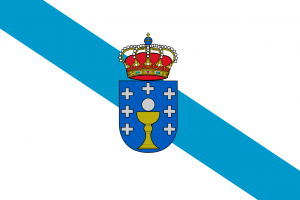Language/Galician/Grammar/Gender
Hi Galician learners! 😊
In this lesson, we will discuss gender in Galician grammar. We will cover the concept of gender, its importance in the Galician language, common gender patterns, and how to use gender correctly. Let's get started!
With the completion of this lesson, consider investigating these related pages: Questions & Future Tense.
Gender in Galician[edit | edit source]
Gender is an important concept in Galician grammar. Every noun in the language has a gender: it is either masculine or feminine. The gender of a noun affects the form of other words in the sentence like articles, adjectives, and pronouns. It's important to understand gender in order to correctly use the language.
While there are some general rules for determining gender in Galician, there are also many exceptions. The best way to learn gender is to memorize the gender of each noun as you learn it. This might seem daunting at first, but it will eventually become second nature.
Let's see some examples:
| Galician | Pronunciation | English |
|---|---|---|
| o gato | ['ɔ ɣa.tu] | the cat (masculine) |
| a pomba | ['a pom.ba] | the dove (feminine) |
| o cao | ['ɔ kaw] | the dog (masculine) |
| a vaca | ['a βa.ka] | the cow (feminine) |
In Galician, we have two genders: masculine (male) and feminine (female). There are some general rules for determining which gender a noun is, but the best way to learn is to memorize each noun as you learn it. Here's an example dialogue:
- Person 1: Vexo un gato. (I see a cat.)
- Person 2: O gato é moi bonito. (The cat is very pretty.)
In the second sentence, "o" is the masculine definite article, which agrees with the gender of "gato." If "gato" were feminine, the article would be "a."
Masculine nouns[edit | edit source]
In Galician, masculine nouns usually end in "-o," "-or," or "-ón." This rule applies to most nouns, but there are many exceptions.
Examples:
| Galician | Pronunciation | English |
|---|---|---|
| o Xosé | ['ɔ ʃo.'se] | Joseph (masculine) |
| o profesor | ['ɔ pro.fes.'or] | the professor (masculine) |
| o león | ['ɔ le.'on] | the lion (masculine) |
It's also common for nouns that refer to male people or animals to be masculine.
Here's another dialogue:
- Person 1: Vin o león no zoolóxico onte. (I saw the lion at the zoo yesterday.)
- Person 2: O león é un animal ferocísimo. (The lion is a very fierce animal.)
In the second sentence, "un" is the masculine indefinite article, which agrees with the gender of "león."
Feminine nouns[edit | edit source]
In Galician, feminine nouns often end in "-a" or "-ión." But again, there are many exceptions.
Examples:
| Galician | Pronunciation | English |
|---|---|---|
| a muller | ['a mu.'ʎeɾ] | the woman (feminine) |
| a canción | ['a kan.'θjon] | the song (feminine) |
| a formiga | ['a for.'mi.ɣa] | the ant (feminine) |
It's also common for nouns that refer to female people or animals to be feminine.
Let's continue the dialogue:
- Person 1: Vin a formiga no xardín hoxe. (I saw the ant in the garden today.)
- Person 2: A formiga é un insecto moi pequeno. (The ant is a very small insect.)
In the second sentence, "un" is the masculine indefinite article, which doesn't agree with the gender of "formiga." We use the masculine article with "insecto," which is masculine.
Gender of adjectives[edit | edit source]
In Galician, adjectives always agree in gender and number with the noun they modify. This means that if the noun is feminine, the adjective must also be feminine, and if the noun is plural, the adjective must also be plural. Let's see some examples:
| Galician | Pronunciation | English |
|---|---|---|
| o gato negro | ['ɔ ɣa.tu 'ne.ɣɾo] | the black cat (masculine) |
| a pomba branca | ['a pom.ba 'bɾaŋ.ka] | the white dove (feminine) |
| os caes bravos | ['os kaes 'βɾa.βos] | the fierce dogs (masculine plural) |
| as vacas marróns | ['as βa.kas ma.'ʁonʃ] | the brown cows (feminine plural) |
Notice how the adjectives "negro," "branca," "bravos," and "marróns" all agree in gender and number with the nouns "gato," "pomba," "caes," and "vacas."
Here's another example dialogue:
- Person 1: Quero comprar uns zapatos novos. (I want to buy some new shoes.)
- Person 2: Tes que probar uns zapatos cómodos. (You have to try on some comfortable shoes.)
In the second sentence, "cómodos" is the plural masculine adjective that agrees with the gender and number of "zapatos."
Neuter nouns[edit | edit source]
Unlike some other languages, Galician doesn't have a neuter gender. Every noun is either masculine or feminine, even if it doesn't seem to fit into either category.
Conclusion[edit | edit source]
In this lesson, we've covered gender in Galician. Remember that gender is an important concept in the language, and that every noun is either masculine or feminine. While there are some general rules for determining gender, the best way to learn is to memorize the gender of each noun as you learn it.
To improve your Galician Grammar, you can also use Polyglot Club. Find native speakers and ask them any questions!
➡ If you have any questions, please ask them in the comments section below.
➡ Feel free to edit this wiki page if you think it can be improved. 😎
Sources[edit | edit source]
Now that you've completed this lesson, don't stop learning! Check out these related topics: Conditional Tense & Plurals.
Other Lessons[edit | edit source]
- Present Tense
- Future Tense
- Negation
- Pronouns
- Prepositions
- Possessive Case in Galician
- Adjectives
- Definite Articles in Galician
- Questions
- Conditional Tense

